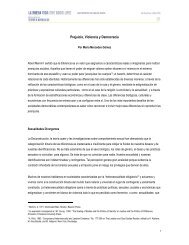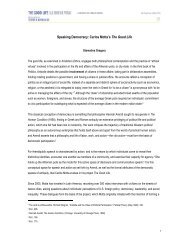Carlos Motta - La buena vida
Carlos Motta - La buena vida
Carlos Motta - La buena vida
Create successful ePaper yourself
Turn your PDF publications into a flip-book with our unique Google optimized e-Paper software.
112<br />
113<br />
hierarchical structure I attempted to explain in<br />
detail the intention of the project and to turn this<br />
into a dialogue as opposed to an interview. But the<br />
“participant objectivation,” however “reflexive,” was<br />
something I couldn’t escape. I believe it to be an<br />
inherent condition to the form...<br />
Second, from a socio-political standpoint,<br />
U.S. intervention and neo-colonialism in <strong>La</strong>tin<br />
America have clearly demarcated the limits and<br />
access of the vast majority of the population to<br />
information and to the formation of an opinion.<br />
Transnational corporations whose economic<br />
interests are at the service of a privileged, often<br />
foreign, elite own <strong>La</strong>tin American media. Their<br />
interest is to keep the audience ignorant, to<br />
manipulate them to believe in and buy their<br />
product. Through the social interactions created<br />
by The Good Life, I wanted to disrupt this<br />
principle to encourage public discussion about<br />
subjects that are not commonly reported by the<br />
local media (It is important to note, though, that<br />
there are large numbers of social movements<br />
of opposition and several independent media<br />
channels primarily in the form of Internet blogs<br />
but also in the form of TV and printed media.)<br />
All of these are forms of uneven and<br />
hierarchical distribution of knowledge, which<br />
widen the gap between subjects and objects<br />
and promote a tyranny of power and ignorance.<br />
The only way to propose a truly democratic<br />
interaction between subjects, to live a “good life”<br />
is, as you imply, to emphasize the construction of<br />
discursive arenas of social exchange; spaces for<br />
dialogue, which might lead to both confrontation<br />
or consent.<br />
ED Let’s get to the online nature of this<br />
archive of discussions, and the feasibility of<br />
imaging this as an Internet “demos” beyond the<br />
temporality of the initial interview. How do you<br />
envision The Good Life existing into the future,<br />
and to what effects?<br />
CM The Good Life is the online archive of<br />
video interviews, the accumulation of these<br />
temporal encounters that now, out of place<br />
and time, seem out-dated, a bit like old news.<br />
From a political point of view, The Good Life is<br />
already dead because of the fast changes in the<br />
landscape of the countries where I conducted<br />
the interviews. Take for example the question<br />
on democracy in relationship to Mexico City, a<br />
place that I visited in August 2005 during Vicente<br />
Fox’s last year in office. The race to succeed him<br />
as president was one of the most contested<br />
and violent elections in the recent history of the<br />
region, and it made the world severely question<br />
the legitimacy and commitment of Mexican<br />
politics to democracy. My interviews do not<br />
reflect this defining moment that surely has<br />
changed the public perception of their system<br />
or rule. I was there too early. I mention this to<br />
suggest how the project is only a snapshot that<br />
may reveal historical patterns in regards to the<br />
issues raised. In that sense its future is precisely<br />
that of any archive.<br />
Its online presence is very important primarily<br />
because it potentially provides access to the<br />
interviewees and other people in the cities where<br />
I worked. I don’t want to sound naive about this,<br />
but being accustomed to the selective audience<br />
of art museums and galleries, the Internet<br />
seems like an endless platform for distribution!<br />
My aim is to distribute this url address via<br />
public libraries and cultural institutions in <strong>La</strong>tin<br />
America and the U.S.<br />
I am a firm believer in the power of alternative<br />
ways of disseminating (counter) information;<br />
it is an essential feature of a democracy. The<br />
Internet in that sense is certainly living up to its<br />
expectations and it is exploding its full potential<br />
to do so. We now have access to multiple of<br />
narratives and that allow us to live and imagine<br />
a decentralized, inclusive, free and democratic<br />
world, even if it is only a virtual illusion.<br />
Eva Díaz is Curator at Art in General. In the<br />
fall of 2008 she defended her Ph.D. from<br />
Princeton University for her dissertation titled<br />
Chance and Design: Experimentation at Black<br />
Mountain College. She is currently working on an<br />
exhibition at Art in General about the influence<br />
of Buckminster Fuller on contemporary art and<br />
alternative architecture called Dome Culture in<br />
the 21st Century.<br />
Installation Views at the Institute of Contemporary Art,<br />
Philadelphia, January-April 2008<br />
part 2<br />
the good life: installation<br />
and internet archive<br />
www.la-<strong>buena</strong>-<strong>vida</strong>.info




